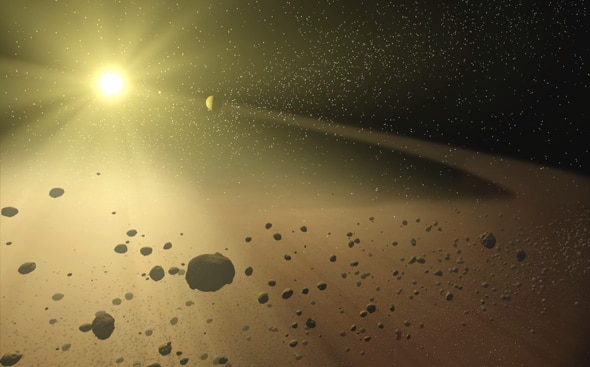Create a free profile to get unlimited access to exclusive videos, sweepstakes, and more!
So Maybe Not Aliens, but How About Comets?

So it’s been a while. Where are we now with the aliens-building-megastructures star?
A quick recap: As you may remember, citizen astronomers combing through Kepler spacecraft data found a very weird star. Kepler stares at thousands of stars looking for dips in their light, indicating a planet passing in front of the star. This is called a transit and is a massively successful way of finding such exoplanets.
Usually, the light from a parent star will have one dip every few days or weeks or so, as the planet orbits it. But the amateurs looking at the data from the star KIC 8462852 found something very different: Lots of little dips happening at irregular intervals, and the occasional big dip. And by big, I mean like 20 percent or more of the star being blocked. That’s colossal, and doesn’t make a lot of sense at first blush; even a huge planet might block only 2 or 3 percent of a star’s light.
The citizen scientists looking at the data were part of a team from Planet Hunters, an effort to get more people looking at Kepler science. They contacted their team leader, Tabetha Boyajian, who then published the data with a series of possible explanations, including perhaps a swarm of comets passing the star and blocking its light. More on that in a sec.
Another explanation is that aliens live on a planet orbiting that star, and are building giant solar collectors to generate the energy needed to sustain an advanced civilization. To be clear, we know this is incredibly unlikely to be the case, but it’s an intriguing idea. SETI even aimed its radio telescopes at the star to see if they could pick up any signals, but nothing so far.
Boyajian herself gave a TED talk about this star, and it’s well worth watching.
Still, Tabby’s Star, as it’s now colloquially called, is intriguing. I’ve never been convinced by the comet explanation. It seems the least unlikely explanation—faint praise!—but a new paper has come out giving it a bit of a boost. The researchers find that a swarm of comets could explain the clusters of smaller dips of starlight. It would take a few hundred comets if they’re each around 10 kilometers across, or a few dozen if they’re 100 kilometers across.
Their explanation actually works pretty well for the small dips, but it still makes me wonder. The comets would be very hard-pressed to explain the two very large dips in light seen in the star, meaning something else would have to be invoked to explain those. That’s not very parsimonious.
And a swarm of comets isn’t a stable thing; after a few thousand years it should break up. For this to work, you’d need a huge object, like the size of Ceres, breaking up for some reason (a huge impact?) with the pieces becoming these comets. Or it could be that we happened to catch the start of a bombardment, a long period of comets dropping down from the outskirts of their solar system, perhaps disturbed by the gravity of a passing planet.
Scientists don’t like coincidences; they’re like a magic wand, too easy to use to solve problems. But they do happen. And it’s worth remembering that we are seeing something very weird happening at this star, something we’ve never seen before, and all the other explanations are even less likely. We might not like picking the least bizarre explanation, but this star is really blowing the curve on what’s normal.
Interestingly, another astronomer found that the star appears to be dimming slowly, over the course of the past century or so at least. I have to wonder if that could be tied to the comets; they tend to be surrounded by clouds of gas and dust, which might contribute to an overall dimming. But other observations showed no signs of these clouds.
Maddening.
So, to answer my first question: Where are we with this star? Still scratching our heads, I think. Comets may explain some of it, but not all. It may be several related things happening at once, or maybe different things happening around the same time. Or it may be just one thing no one has thought of yet.
It’s a mystery, but a fun one. What’s going on? We just don’t know. But more observations (not just of this one star, but as many others as possible, too, to see whether Tabby’s Star is unique), and more people thinking about it are the way to go. The aliens idea may make this seem silly, but the data are real. Something is going on around this star. I don’t know what it might be, but what I can guarantee is that when we do figure it out, it’ll be something pretty amazing.


























